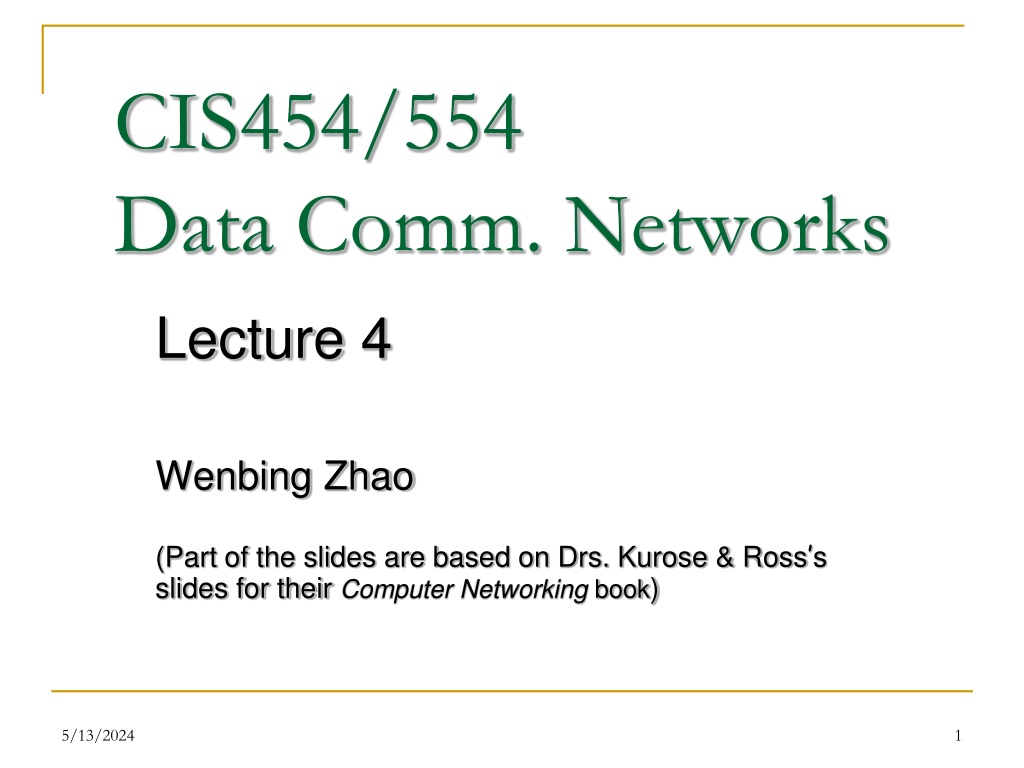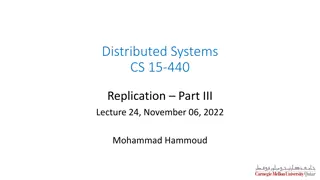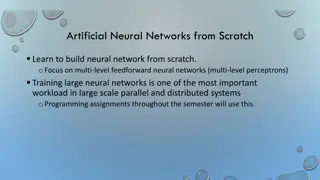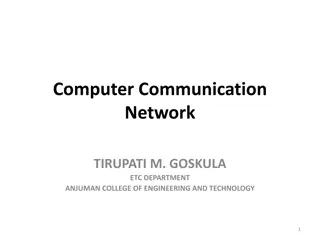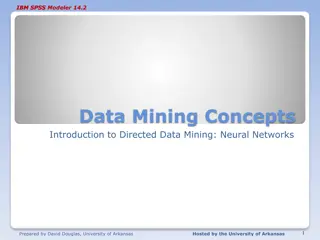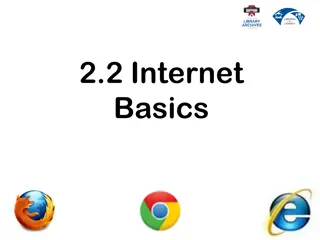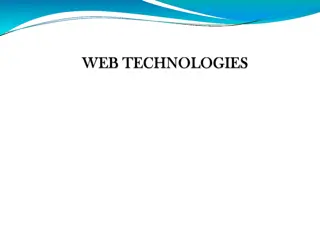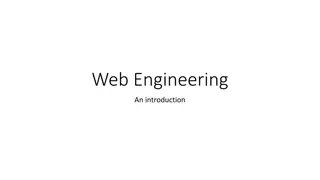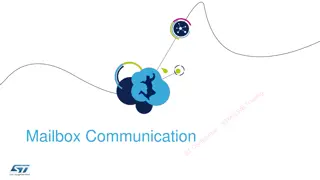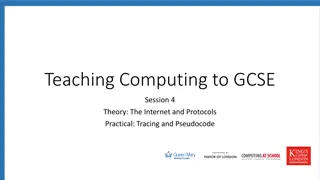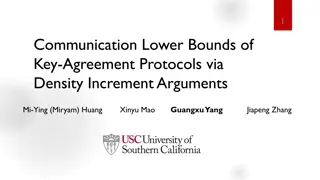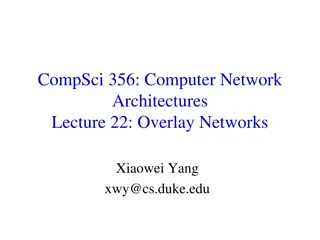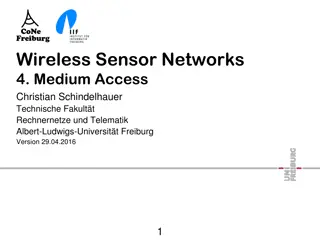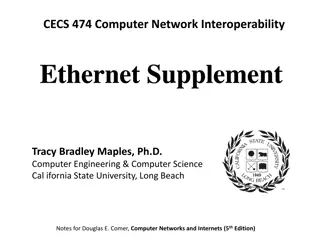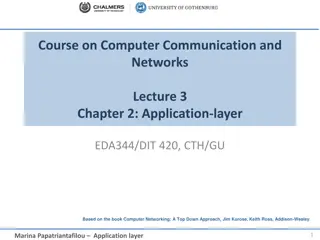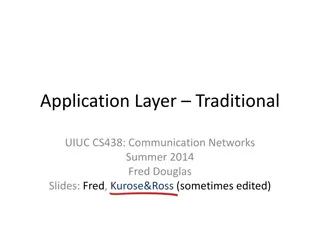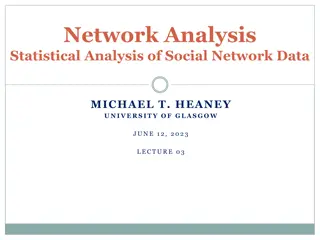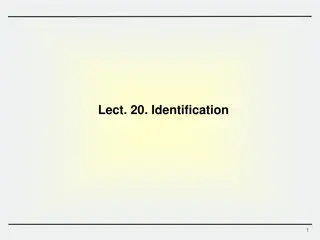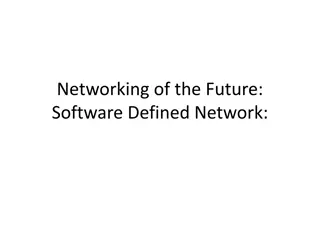Introduction to Web and HTTP Protocols in Data Communication Networks
Explore the fundamental concepts of the World Wide Web and Hypertext Transfer Protocol (HTTP) as integral parts of data communication networks. Delve into the history, structure, and key components of the web, including HTML, common tags, URLs, and HTTP. Understand how information is accessed, transmitted, and displayed on web pages through client-server communication models. Gain insights into the evolution and significance of web technologies in modern networking landscapes.
Download Presentation

Please find below an Image/Link to download the presentation.
The content on the website is provided AS IS for your information and personal use only. It may not be sold, licensed, or shared on other websites without obtaining consent from the author. Download presentation by click this link. If you encounter any issues during the download, it is possible that the publisher has removed the file from their server.
E N D
Presentation Transcript
CIS454/554 Data Comm. Networks Lecture 4 Wenbing Zhao (Part of the slides are based on Drs. Kurose & Ross s slides for their Computer Networking book) 5/13/2024 1
Administrative: Lab report requirement: Submit in blackboard Typed, must include questions/tasks, your answers, and screenshots to backup your answers Today s topics Web and HTTP 5/13/2024 Wenbing Zhao
The World Wide Web Creation of Tim Berners-Lee, in 1989 CERN nuclear physics research Mosaic first graphical interface, creation of Marc Andersson (and others), precursor to Netscape Uses a client-server architecture Web server Web browser Runs on HTTP over TCP 5/13/2024 Wenbing Zhao
Web and HTTP Web page consists of objects Object can be HTML file, JPEG image, Java applet, audio file, A Web page consists of a base HTML-file which includes several referenced objects Each object is addressable by a URL The idea of having one page point to another is called hypertext Invented by Vannevar Bush, a MIT EE professor, in 1945 5/13/2024 Wenbing Zhao
HTML HyperText Markup Language The HTML for a sample Web page The formatted page 5/13/2024 5
Common HTML Tags 5/13/2024 6
URL Uniform Resource Locater Example URL: http://www.someschool.edu/someDept/pic.gif path name host name protocol name URL encodes three types of information What is the page called local path name uniquely indicating the specific page Where is the page located Host name of the server on which the page is located How can the page be accessed protocol, e.g., http, ftp 5/13/2024 Wenbing Zhao
HTTP Overview HTTP: HyperText Transfer Protocol Web s application layer protocol client/server model HTTP 1.0: RFC 1945 HTTP 1.1: RFC 2068 PC running Explorer Server running Apache Web server Mac running Navigator 5/13/2024 Wenbing Zhao
HTTP Overview Client initiates TCP connection (creates socket) to server, port 80 Server accepts TCP connection from client HTTP messages (application-layer protocol messages) exchanged between browser (HTTP client) and Web server (HTTP server) TCP connection closed 5/13/2024 Wenbing Zhao
HTTP Overview HTTP is stateless Server maintains no information about past client requests Protocols that maintain state are complex! Past history (state) must be maintained If server/client crashes, their views of state may be inconsistent, must be reconciled 5/13/2024 Wenbing Zhao
HTTP Connections Nonpersistent HTTP At most one object is sent over a TCP connection HTTP/1.0 uses nonpersistent HTTP Persistent HTTP Multiple objects can be sent over single TCP connection between client and server HTTP/1.1 uses persistent connections in default mode 5/13/2024 Wenbing Zhao
Nonpersistent HTTP Suppose user enters URL http://www.someSchool.edu/someDept/home.index 1a. HTTP client initiates TCP connection to HTTP server at www.someSchool.edu on port 80 (contains text, references to 10 jpeg images) 1b. HTTP server at host www.someSchool.edu waiting for TCP connection at port 80. accepts connection, notifying client 2. HTTP client sends HTTP request message (containing URL) into TCP connection socket. Message indicates that client wants object someDept/home.index 3. HTTP server receives request message, forms response message containing requested object, and sends message into its socket time 5/13/2024 Wenbing Zhao
Nonpersistent HTTP 4. HTTP server closes TCP connection. 5. HTTP client receives response message containing html file, displays html. Parsing html file, finds 10 referenced jpeg objects 6. Steps 1-5 repeated for each of 10 jpeg objects time 5/13/2024 Wenbing Zhao
Non-Persistent HTTP: Response Time Definition of RTT: time to send a small packet to travel from client to server and back (Round Trip Time) initiate TCP connection RTT request file time to transmit file RTT file received time time 5/13/2024 Wenbing Zhao
Non-Persistent HTTP: Response Time Response time: one RTT to initiate TCP connection one RTT for HTTP request and first few bytes of HTTP response to return file transmission time Total = 2RTT+transmission time 5/13/2024 Wenbing Zhao
Non-Persistent HTTP Issues Requires 2 RTTs per object OS overhead for each TCP connection To reduce response time, browsers often open parallel TCP connections to fetch referenced objects 5/13/2024 Wenbing Zhao
Persistent HTTP Server leaves connection open after sending response Subsequent HTTP messages between same client/server sent over open connection 5/13/2024 Wenbing Zhao
Persistent HTTP Persistent without pipelining: Client issues new request only when previous response has been received One RTT for each referenced object Persistent with pipelining: Default in HTTP/1.1 Multiple requests are sent over the same connection concurrently. That is, after the first request, the second request is sent before the reply for the first request is received As little as one RTT for all the referenced objects 5/13/2024 Wenbing Zhao
HTTP Request Message Two types of HTTP messages: request, response HTTP request message: ASCII (human-readable format) request line (GET, POST, HEAD commands) GET /somedir/page.html HTTP/1.1 Host: www.someschool.edu User-agent: Mozilla/4.0 Connection: close Accept-language:fr header lines Carriage return, line feed indicates end of message (extra carriage return, line feed) 5/13/2024 Wenbing Zhao
HTTP Request Message: General Format HTTP header is pure ASCII based. It is very different from lower layer protocols such as TCP, which is binary based 5/13/2024 Wenbing Zhao
Method Types HTTP/1.0 GET POST HEAD Asks server to include only the header part in response HTTP/1.1 GET, POST, HEAD PUT Uploads file in entity body to path specified in URL field DELETE Deletes file specified in the URL field 5/13/2024 Wenbing Zhao
HTTP Response Message status line (protocol status code status phrase) HTTP/1.1 200 OK Connection close Date: Thu, 06 Aug 1998 12:00:15 GMT Server: Apache/1.3.0 (Unix) Last-Modified: Mon, 22 Jun 1998 ... Content-Length: 6821 Content-Type: text/html data data data data data ... header lines data, e.g., requested HTML file 5/13/2024 Wenbing Zhao
HTTP Response Status Codes Status code is in first line of the response message: 200 OK request succeeded, requested object later in this message 301 Moved Permanently requested object moved, new location specified later in this message (Location:) 400 Bad Request request message not understood by server 404 Not Found requested document not found on this server 505 HTTP Version Not Supported 5/13/2024 Wenbing Zhao
Web Caching Goal: satisfy client request without involving origin server user sets browser: Web accesses via proxy server browser sends all HTTP requests to proxy server object in cache: returns cached object else cache requests object from origin server, then returns object to client origin server Proxy server client client origin server 5/13/2024 Wenbing Zhao
More about Web Caching Proxy server acts as both client and server Typically proxy server is installed by ISP (university, company, residential ISP) Why Web caching? Reduce response time for client request Reduce traffic on an institution s access link Internet dense with caches: enables poor content providers to effectively deliver content 5/13/2024 Wenbing Zhao
Conditional GET: HTTP Build-in Support for Caching Origin Server Proxy server HTTP request msg If-modified-since: <date> Goal: don t send object if cache is up-to-date Proxy server: specify date of cached copy in HTTP request If-modified-since: <date> Origin server: response contains no object if cached copy is up-to-date: HTTP/1.0 304 Not Modified object not modified HTTP response HTTP/1.0 304 Not Modified HTTP request msg If-modified-since: <date> object modified HTTP response HTTP/1.0 200 OK <data> 5/13/2024 Wenbing Zhao
Non-Caching Example origin servers Assumptions Average object size = 100,000 bits Avg. request rate from institution s browsers to origin servers = 15/sec Delay from institutional router to any origin server and back to router = 2 sec public Internet 1.5 Mbps access link institutional network 10 Mbps LAN 5/13/2024 Wenbing Zhao
Non-Caching Example origin servers Consequences Utilization on LAN = 15% Utilization on access link = 100% Total delay = Internet delay + access delay + LAN delay = 2 sec + minutes + milliseconds public Internet 1.5 Mbps access link institutional network 10 Mbps LAN 5/13/2024 Wenbing Zhao
Non-Caching Example origin servers Possible solution Increase bandwidth of access link to, say, 10 Mbps Consequences Utilization on LAN = 15% Utilization on access link = 15% Total delay = Internet delay + access delay + LAN delay = 2 sec + msecs + msecs Often a costly upgrade public Internet 10 Mbps access link institutional network 10 Mbps LAN 5/13/2024 Wenbing Zhao
Caching Example origin servers Install proxy server Suppose hit rate is 0.4 Consequence 40% requests will be satisfied almost immediately 60% requests satisfied by origin server Utilization of access link reduced to 60%, resulting in negligible delays (say 10 msec) Total avg delay = Internet delay + access delay + LAN delay = .6*(2.01) secs + .4*milliseconds < 1.4 secs public Internet 1.5 Mbps access link institutional network 10 Mbps LAN Institutional Proxy server 5/13/2024 Wenbing Zhao
Homework#1.3 Objective 3: Able to understand how a Uniform Resource Locater is constructed and its internal components Problem. Imagine that someone in the CS Department at Stanford has just written a new program that he wants to distribute by FTP. He puts the program in the FTP directory ftp/pub/freebies/newprog.c. What is the URL for this program likely to be? 5/13/2024 31
Homework#1.4 Objective 4: Able to understand the built-in support for caching in HTTP and the HTTP protocol itself Key point: HTTP has support for a conditional get request to work with the caching so that the network traffic can be reduced and the end-to-end latency is shortened Problem. The If-Modified-Since header can be used to check whether a cached page is still valid. Requests can be made for pages containing images, sound, video, and so on, as well as HTML. Do you think the effectiveness of this technique is better or worse for JPEG images as compared to HTML? 5/13/2024 32
Homework#1.5 Objective 5: Able to compute the response time as seen by a client that issued a HTTP request. Key point: Queueing delay at the router can be a significant factor in response time The heavier the traffic, the longer the queue at the router, which causes the longer delay Using caching, a portion of the HTTP requests will be served at the local proxy server instead of computing for resources at the router, which reduces the queue at the router and shorten the response time Problem. Consider an institutional network connected to the internet. Suppose that the average object size is 900,000 bits and that the average request rate from the institution s browsers to the origin servers is 1.5 requests per second. The bandwidth of the access link is 1.5 Mbps. Also suppose that the amount of time it takes from when the router on the Internet side of the access link forwards an HTTP request until it receives the response in two seconds on average. Model the total average response time as the sum of the average access delay (that is, the delay from Internet router to institution router) and the average Internet delay. For the average access delay, use D/(1-Db), where D is the average time required to send an object over the access link and b is the arrival rate of objects to the access link. (1)Find the total average response time. (2) Now suppose a cache is installed in the institutional LAN. Suppose the hit rate is 0.4. Find the total average response time 5/13/2024 33
Homework#1.6 Objective 6: Able to fully understand HTTP Key points HTTP has two versions so far: 1.0 and 1.1 HTTP 1.0: TCP connection is not persistent, that is, to retrieve any object, a new TCP connection is made and then is terminated HTTP 1.1: Support persistent TCP connection in that the same connection is used to retrieve multiple objects if necessary TCP uses a three-way handshake to establish a new connection, which adds a round trip delay by itself Problem: Suppose within your Web browser you click on a link to obtain a Web page. The IP address for the associated URL has already been cached in your local host so a DNS look-up is unnecessary. Suppose that the Web page associated with the link contains some HTML text and 20 jpeg images that are hosted on the same Web server. Let RTT0 denote the RTT between the local host and the Web server. Assuming 0 transmission time of the HTML text and the embedded images, calculate how much time elapses from when the client clicks on the link until the client receives the Web page (HTML text and the embedded images) under the following scenarios: HTTP 1.1 with pipelining (and with persistent connection) HTTP 1.1 without pipelining (and with persistent connection) 5/13/2024 34
